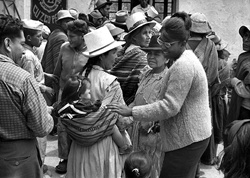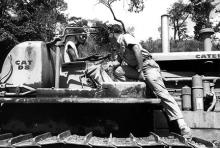What Motivates You To Seek A Service Position As A Peace Corps Volunteer?
Through the Peace Corps, President John F. Kennedy sought to encourage mutual understanding between Americans and people of other nations and cultures.
On Oct 14, 1960, at 2 a.m., Senator John F. Kennedy spoke to a crowd of ten,000 auspicious students at the University of Michigan in Ann Arbor during a presidential campaign spoken language. In his improvised speech, Kennedy asked, "How many of yous, who are going to be doctors, are willing to spend your days in Ghana? Technicians or engineers, how many of you lot are willing to piece of work in the Strange Service and spend your lives traveling effectually the globe?" His young audition responded to this oral communication with a petition signed by i,000 students willing to serve abroad. Senator Kennedy's challenge to these students—to alive and work in developing countries around the earth; to dedicate themselves to the cause of peace and development—inspired the start of the Peace Corps.
Only two weeks later, in his November ii, 1960, speech at the Moo-cow Palace in San Francisco, Kennedy proposed "a peace corps of talented men and women" who would dedicate themselves to the progress and peace of developing countries. Encouraged by more than 25,000 letters responding to his call, Kennedy took immediate activeness every bit president to make the entrada hope a reality.
The Cold War and the Peace Corps
The Peace Corps program was an outgrowth of the Cold State of war. President Kennedy pointed out that the Soviet Union "had hundreds of men and women, scientists, physicists, teachers, engineers, doctors, and nurses . . . prepared to spend their lives away in the service of world communism." The U.s. had no such program, and Kennedy wanted to involve Americans more actively in the cause of global republic, peace, evolution, and freedom.
A few days after he took office, Kennedy asked his brother-in-law, R. Sargent Shriver, to direct a Peace Corps Chore Force. Shriver was known for his ability to identify and motivate creative, visionary leaders, and he led the group to chop-chop shape the system. After a month of intense dialogue and debate amongst task force members, Shriver outlined seven steps to forming the Peace Corps in a memorandum to Kennedy in February 1961.
The Peace Corps was established by executive club on March ane, 1961, and a reluctant Shriver accustomed the president's request to officially lead the organization. Shriver recruited and energized a talented staff to implement the task force'south recommendations. On his kickoff trip abroad as manager, he received invitations from leaders in India, Ghana, and Burma to place Peace Corps volunteers in their countries.
Tanganyika (present-24-hour interval Tanzania) and Ghana were the first countries to participate in the programme. President Kennedy welcomed the inaugural grouping of volunteers at the White House on August 28, 1961, to give them a personal good day before their departure to Africa.
Congress approved the Peace Corps as a permanent federal agency within the Country Department, and Kennedy signed the legislation on September 22, 1961. In 1981, the Peace Corps was made an independent agency.
In the 1960s, the Peace Corps was very popular with recent college graduates. Simply in the 1970s, the Vietnam War and Watergate eroded many Americans' faith in their government. Interest in the Peace Corps began to decline and authorities funding was cut. In the 1980s, President Ronald Reagan tried to broaden the Peace Corps' traditional business with education and agriculture to include more than current fields such equally computer literacy and business-related pedagogy. For the commencement time, a rising number of conservative and Republican volunteers joined the largely progressive Peace Corps contingent overseas. Peace Corps membership and funding increased afterwards the opening of Eastern Europe in 1990.
The Peace Corps Plan
To participate in the Peace Corps program, countries must run into certain requirements:
- A country must invite the Peace Corps
- Based on its limited upkeep, the Peace Corps decides which countries it can be active in and prioritizes each country's needs
- Peace Corps volunteers must be condom
Once these requirements are met, the Peace Corps begins working with the foreign government. Countries seeking assist from the Peace Corps propose areas that could benefit from the skills of volunteers. The Peace Corps and so matches assignments within foreign nations to applicants with the appropriate skills.
Life as a Peace Corps volunteer is not easy and volunteers confront many challenges, from language barriers to poor living conditions. There is no salary. Volunteers receive a monthly stipend for room, board, and few essentials—"plenty to be at a level sufficient only to maintain health and basic needs. Men and women volition be expected to work and live alongside the nationals of the land in which they are stationed—doing the aforementioned piece of work, eating the same food, talking the same language."
Culturally, volunteers work to build trust within their communities and share their skills to solve challenges that face developing communities. Volunteers piece of work in many unlike fields, including, educational activity, health, nutrition, HIV/AIDS training, agriculture, business, community development, forestry, and environmental protection. Since the inception of the Peace Corps, some 200,000 volunteers have served in 139 countries. They have learned more than 200 languages and dialects.
The Peace Corps Today
The Peace Corps is always adapting to the times and to an e'er-changing earth, only has never wavered from its three original goals:
- To help the people of interested countries and areas in meeting their needs for trained workers
- To aid promote a better understanding of Americans on the part of the peoples served
- To help promote a improve understanding of other peoples on the part of Americans
The plan continues to reflect the evolving priorities of the US regime and changes in the population of the United States. Today, on average, volunteers are older than their predecessors and more experienced in specialized fields.
Later on more than five decades of service, the Peace Corps is more than vital than ever and still growing. From John F. Kennedy's inspiration came an bureau devoted to world peace and friendship and volunteers who proceed to assist individuals build a amend life for themselves, their children, their community, and their country.
What Motivates You To Seek A Service Position As A Peace Corps Volunteer?,
Source: https://www.jfklibrary.org/learn/about-jfk/jfk-in-history/peace-corps
Posted by: palmerwhinsise1961.blogspot.com





0 Response to "What Motivates You To Seek A Service Position As A Peace Corps Volunteer?"
Post a Comment